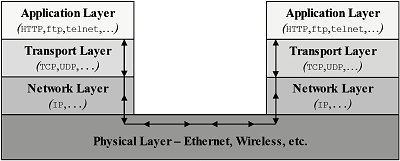
| Home : Course Map : Chapter 13 : |
|
Networking Overview
|
| JavaTech |
| Course Map |
| Chapter 13 |
|
Network
Overview |
| About
JavaTech Codes List Exercises Feedback References Resources Tips Topic Index Course Guide What's New |
|
Networking architecture is based on the concept of layers. From Java Network Programming (Harold, 2000.) comes this layer model: (A more formal OSI - Open System Interconnection - model has 7 layers but this one shows the essential layer definitions.) Each layer has its own standardized protocols and applications programming interface (API ), which refers to the functions, and their arguments and return values, called by the next higher layer. Internally, the layers can be implemented in different ways as long as externally they obey the standard API. For example, the Network Layer does not know if the Physical Layer is Ethernet or a wireless system because the device drivers respond to the function calls the same way. The Internet refers primarily to the Network Layer that implements the Internet Protocol (IP) and the Transport Layer that implements the Transmission Control Protocol (TCP). In fact, you often here people refer to the "TCP/IP" network rather than calling it the Internet. The application layer also includes various protocols, such as FTP (File Transport Protocol) and HTTP (Hypertext Transfer Protocol) for the Web, that rely on the TCP/IP layers. Most users never look below the application layer. Most application programmers never work below the TCP/IP layers.
References & Web Resources
Latest update: Dec. 8, 2004 |
